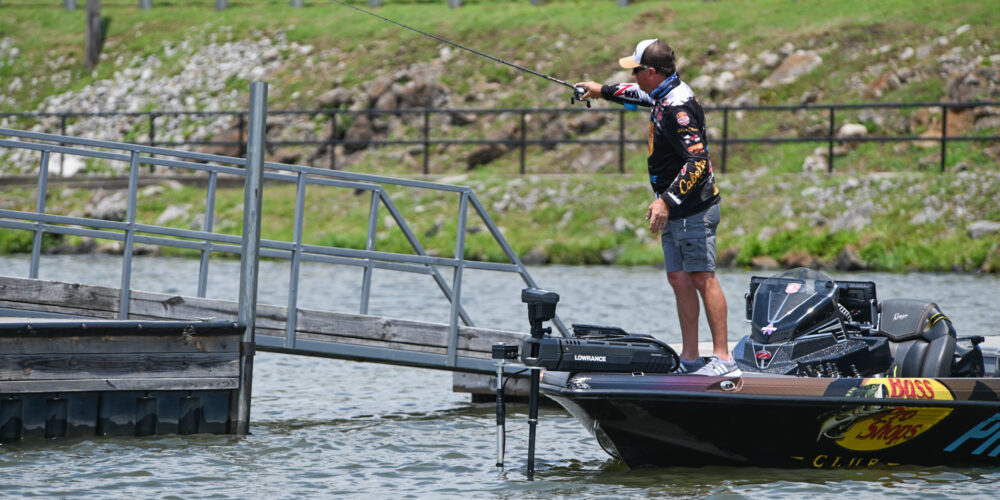Walker Favors Finesse Jigs for Finicky Fall Bass

For several decades while he was a resident of East Tennessee, MLF pro David Walker spent many of his fall days fishing local reservoirs. That wealth of experience has helped the Mercury Pro Team angler narrow down his approach during one of the most difficult times of the year to catch bass.
“Fall fishing can be really tough, a lot of people don’t (even) go out then,” Walker said. “But the fall can also be a little more predictable with what baits to use and where to find the bass.”
Walker essentially uses a two-lure approach, with a heavy emphasis on a finesse jig.
“I use a topwater as a search bait, then flip every little bit of cover,” Walker said. “But I really use a jig more than anything in the fall. Largemouth, smallmouth and spotted bass will all eat a jig, it’s just such a versatile bait.”
Walker appreciates the level of control he can exert in the action of a jig, and he appreciates how fishable the bait is in almost any circumstance, in any color of water, and in any cover. However, not just any old jig will do.
“I use finesse jigs in the fall,” Walker said. “I gravitated to them early in my career because they’re so versatile. You can customize a finesse jig and make it whatever you want it to be. It’s all about getting the right feel. Also, during fall, the smaller jig profile gets more bites. Seems like fish this time of year aren’t as aggressive to lures – they’re usually chasing bait, and it can be tough to get them to chase yours (if it’s bigger than the baitfish).”
Small Sizes, Natural Colors
Walker’s finesse jig of choice is usually a 3/8-ounce Z-Man CrossEyeZ Power Finesse Jig, though occasionally he’ll use a 1/4-ounce version.
“The 3/8-ounce is a little heavier, making it easier to cast and pitch,” Walker said. “Plus, this jig has a 2/0 heavy-wire, round-bend hook. It’s not like a lot of the finesse jigs with light wire. You can really work it through heavy cover and use your standard jig fishing rod.”
Natural colors for both jigs and trailers are Walker’s preference, because many Southern reservoirs he fishes often have clearer water in the fall.
“My color choice will skew more to brown than black,” Walker said. “It’s due to the clearer water usually associated with fall. I like the moccasin color, pond scum, and natural craw with a little red. Green pumpkin trailers are always good. I can’t see myself using any other color that time of year.”
Shallow means SHALLOW
Walker starts his fall search shallow – as in really shallow.
“Lakes are being drawn down toward the winter pool, so the amount of cover gets pretty lean and a lot of the time it’s really shallow,” he said. “Bass can be in cover so shallow you won’t believe it – stupid shallow. Fish can be in inches and not feet of water. That’s why the smaller and subtle finesse jig has great appeal.
To coax fall bass to bite your jig, repetitive casts to the same piece of cover are often necessary. Make the same pitch several times. If a bass doesn’t take it, move a little and change your angle. Then, repeat the multiple-pitch-and-cast approach.
“Don’t assume the first cast will get them to bite,” Walker said. “You’ll often really need to pick the cover apart. Multiples of the same pitch are often what it takes.”
When it comes to the specific type of fall cover he prefers, Walker says that anything goes. If you see it, pitch your jig to it.
“Lots of times cover is limited, so I don’t get hung up looking for a certain cover,” he said. “I look for whatever is there – rocks, docks, wood, brush piles, could be an old pontoon boat. Really, whatever there is, pitch at it.”
Expectations regarding volume of bass caught need to be managed during the fall season.
“Go into the day of fishing knowing it’s not likely going to be a 50-fish day,” Walker said. “Just try to catch a fish. Each piece of cover may be that one fish. Have a lot of patience. There are always exceptions, but fishing Southern reservoirs in fall can be tough, even in the best (conditions).”